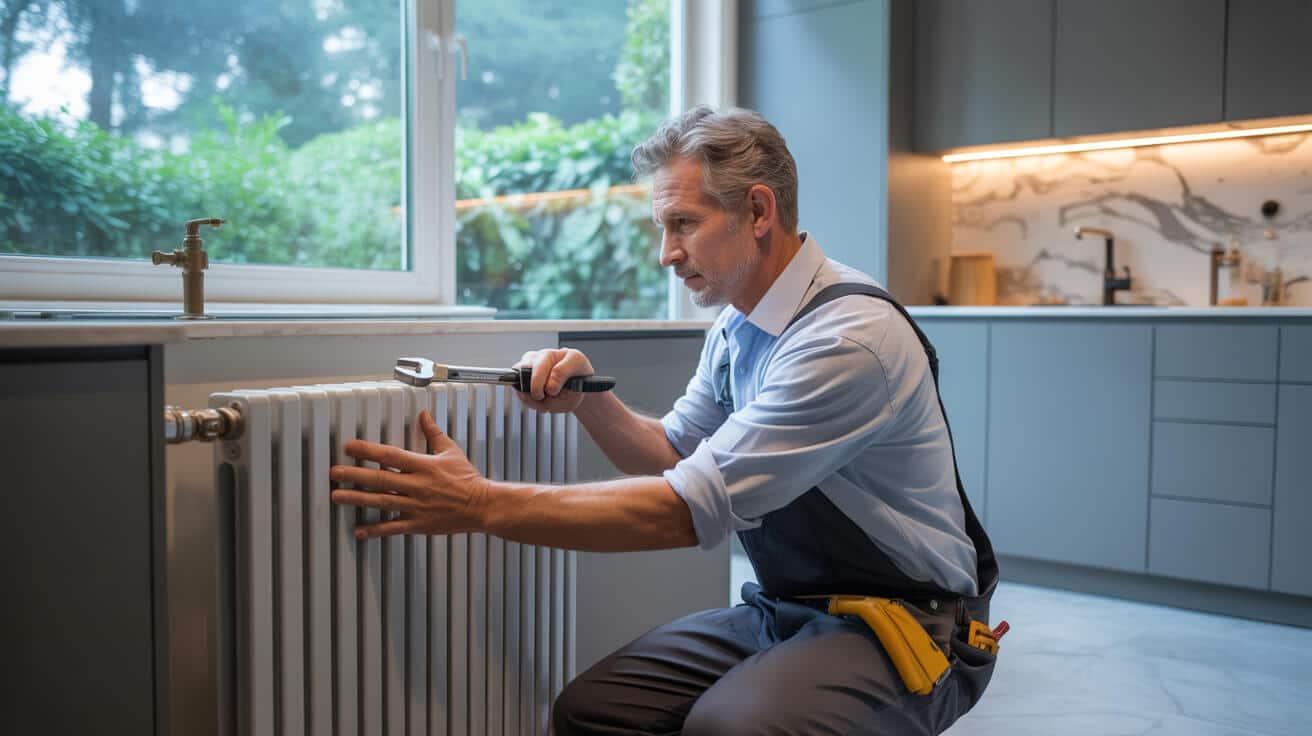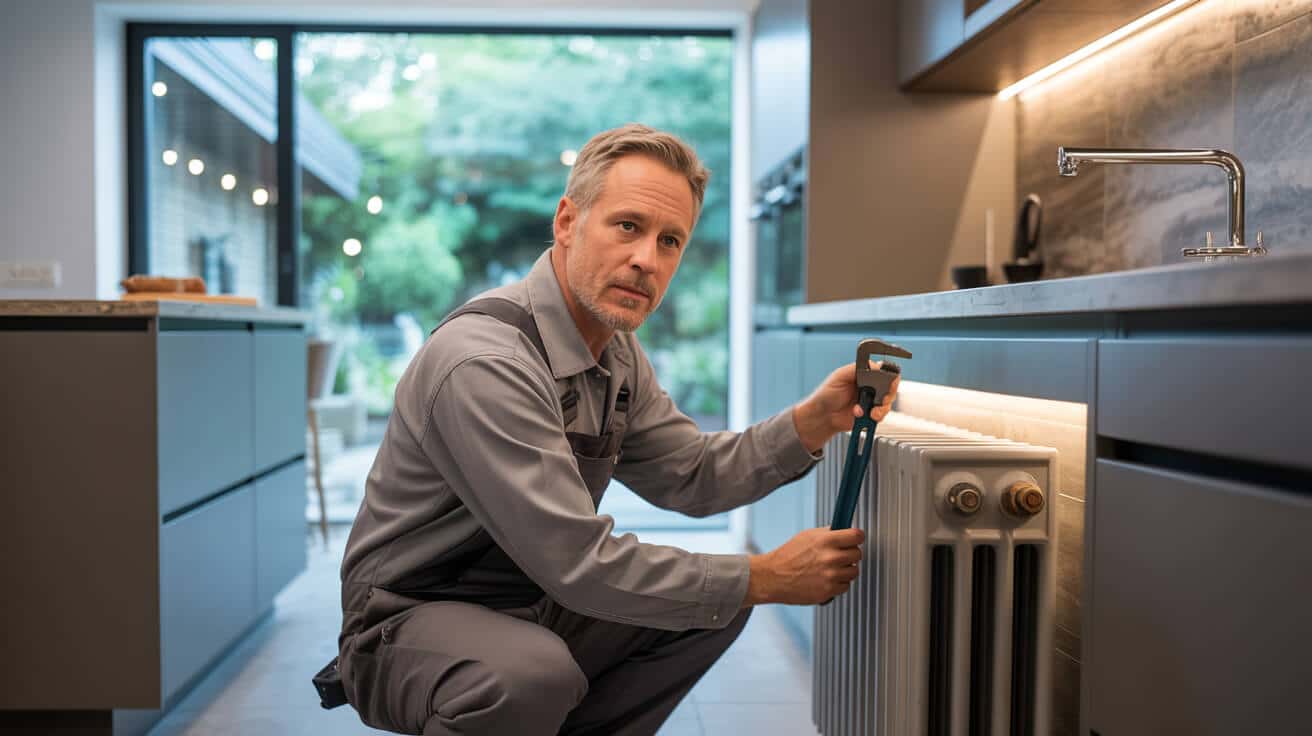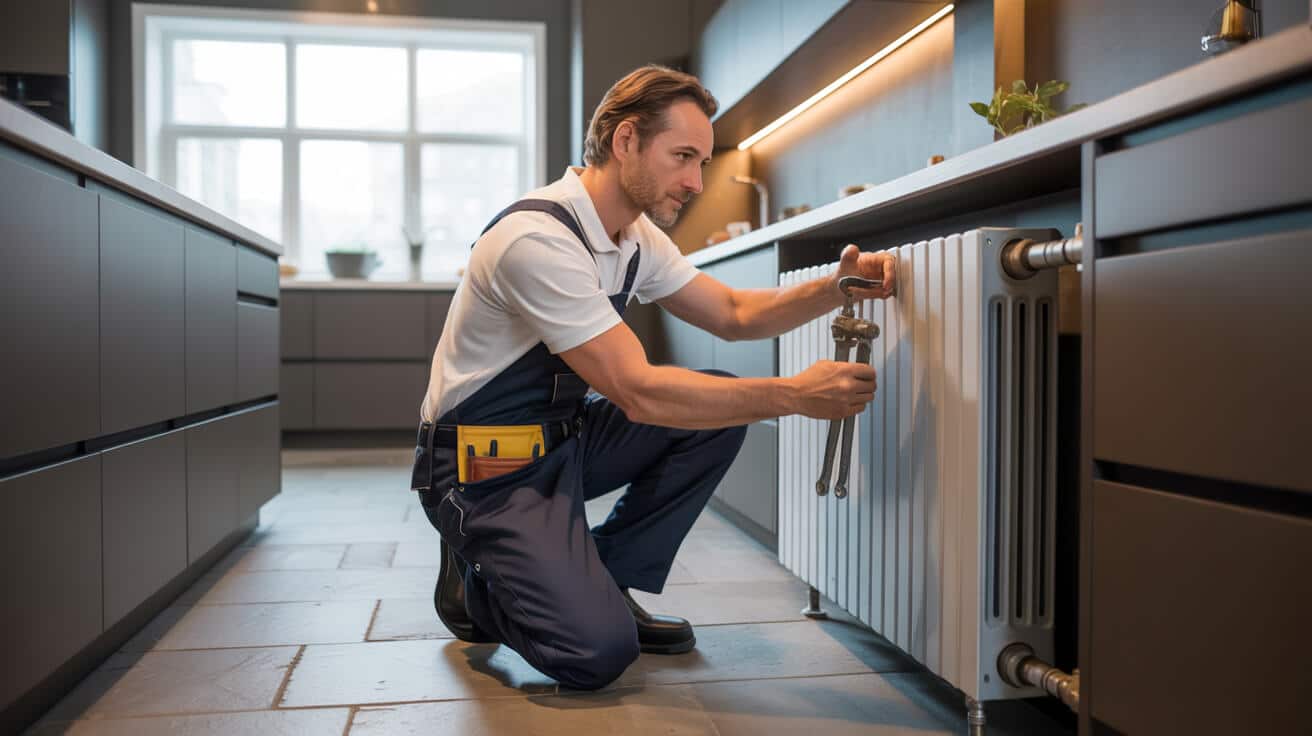Heating systems are engineered to maintain indoor warmth, safeguard property assets, and meet statutory obligations regarding habitability and workplace standards. A single cold radiator can reduce a living space’s comfort, distort system efficiency, and escalate operational costs for your company or residence. Faults in radiator function are not only a sign of local system disruption—they signal potential inefficiencies, legal exposure for landlords, or lapses in routine maintenance for property managers. The complexity of modern heating circuits introduces new challenges in diagnosing and resolving these disruptions, requiring both technical comprehension and an awareness of regulatory and user expectations.
Etymology or Name Origin
The term “radiator” derives from the Latin “radiare,” meaning “to beam or emit rays.” In the context of building services engineering, the word was adopted during the 19th century when the earliest hot water heating installations described their cast iron panels as “radiators” owing to their capacity to emit heat via both radiation and convection. Although contemporary designs strive for convective efficiency, the historical nomenclature remains intact, underscoring an enduring connection between etymology and technological innovation in climate control.
Overview and Context
Hydronic heating, also known as wet central heating, deploys radiators as terminal units in an interconnected circuit, using water as a heat conveyor from a primary source such as a boiler, heat pump, or district heating system. Radiators are found in a spectrum of settings—private homes, rental properties, housing associations, offices, communal spaces, educational institutions, healthcare environments, and industrial premises. System architectures vary; traditional one-pipe or gravity-fed installations persist in legacy buildings, while most modern properties adopt sealed, pressurised loops with advanced control and zoning. In every scenario, your radiator’s performance is a function of engineering design, component quality, water chemistry, and scheduled maintenance. A non-heating radiator frequently indicates a local or systemic breakdown in one or more of these elements.
Hydronic Heating Principles
Hot water, propelled by a pumped circuit, flows through a network of pipes and radiators. As the water circulates, it releases thermal energy via the metallic surface of each emitter. The water then returns to the heat source to be reheated, allowing continuous heat distribution.
Building Use Cases
- Domestic: Most UK homes employ radiators as their principal heating emitters; rooms may be individually controlled by manual or thermostatic valves.
- Rented Properties: Landlords are legally required to provide effective heating. Failure often triggers tenant complaints, compliance checks, and urgent repair calls.
- Commercial & Institutional: Offices, schools, and care facilities have higher performance and compliance obligations. In multi-occupancy buildings, one cold radiator can indicate wider system health issues.
System Variability
System efficacy is affected by property age, pipework design, water treatment, and intermittency of occupation. Block or estate managers may encounter a wide array of legacy systems, demanding a scalable approach to diagnostics and maintenance.
History
Origins
Radiator technology took shape in the early 1800s, initially serving industrial and high-value residential applications. Early cast iron units provided large heat storage capacity, offsetting inconsistent fuel quality and supply.
Industrial Emergence
The late Victorian era ushered in mass adoption in commercial, public, and eventually middle-class housing. Mild steel supplanted cast iron by the mid-20th century due to improved heat transfer properties and form flexibility. The expansion of district and municipal heating systems saw radiators become a mainstay in European urban engineering.
Contemporary Evolution
With energy crises in the latter 20th century, focus shifted from brute BTU delivery to responsive zoning, modulation, and thermal insulation. By the 1990s, regulatory frameworks (including the UK’s Part L and energy performance certificates) made efficient radiator and control system design a legal requirement. Recent trends emphasise smart controls, recyclable materials, and low-temperature compatibility as the built environment targets net-zero heating.

Concept / Description
Principles of Radiator Operation
Radiators function as passive heat exchangers. Heated water enters at one port, traverses internal channels or fins, and exits at a lower temperature having imparted energy to the surrounding air through metallic conduction and secondary convection.
Physical Construction
- Panel Radiators: Sheet steel stamped and welded for maximum convective surface area; most common in homes.
- Column Radiators: Multiple joined columns enhance surface area, often used for aesthetic or retrofit purposes.
- Compact & LST Models: Enhanced with internal fins or external guards, used in settings with vulnerability or safety constraints.
Integration and Ancillary Components
- Valves: Manual or thermostatic elements controlling flow and room set-point.
- Pipework: Copper, plastic (polybutylene, PEX), steel; may be hidden or exposed.
- Circulation Pumps: Ensure consistent flow for all radiators in the network; mis-sizing or failure is a frequent root cause of uneven heating.
- Thermostats/Controls: Programmable, analogue, or smart zoning solutions provide graduated or schedule-driven operation.
Functionality / Purpose / Applications
Purpose in Residential Heating
Radiators supply zonal heating, giving precise temperature control over specific rooms or sections of a building. Radiator placement and size are selected based on heat loss calculations and occupancy needs, ensuring each area remains within comfort bands.
Building & Organisational Applications
- Single-family dwellings, apartments, bungalows:
- Rented housing managed by landlords or agencies: Immediate restoration of heating is often a legal requirement.
- Offices and retail: Loss of local heating can reduce productivity and increase complaints.
- Healthcare and care homes: Vulnerable occupants require higher minimum temperature thresholds and reliable, low-temperature systems.
- Education: Multi-zone schemes, often with historic or legacy infrastructure.
Critical Use Cases
Radiator operation is doubly significant in facilities serving vulnerable populations (children, elderly, patients) where inadequate heating may result in immediate health, safety, or regulatory breaches.
Classifications / Types / Variants
Radiator Types
- Standard Panel: Flat or profiled; prevalent in most residential settings.
- Column or Tubular: Retrofitted or specified for period properties or specific design influence.
- Low Surface Temperature (LST): Fitted with insulating covers in institutional settings.
- Designer/Electric: Chosen for unique requirements; typically not hydronically integrated.
Valve and Control Variants
- Manual: Simple on/off; commonly seen in older installations.
- Thermostatic Radiator Valves (TRVs): Self-modulating, control individual temperatures; increasingly mandated in new and replacement systems.
- Smart Valves: Communicate with central hubs or apps, supporting time-based, remote, adaptive, or learning controls.
System Topology
- Single- vs. Dual-pipe: Dual-pipe circuits ensure balanced, rapid hot water delivery; single-pipe systems may yield sequential heat loss, complicating diagnosis.
- Pressurised vs. Open-vented: Modern sealed systems run at 1–2 bar; open-vented designs are gravity-fed and more susceptible to air ingress.
Systems / Tools / Methodologies
Diagnostic Sequence
- Visual Inspection: Identify obvious leaks, corrosion, or mechanical valve dislocation.
- System Pressure Test: Check via boiler gauge or digital app; low pressure signifies leak or loss.
- Bleeding Test: Test for air in radiator; use bleed key to release trapped air until water runs freely.
- Valve Function Test: Check that TRVs and lockshields rotate and operate freely; ensure caps are not stuck or seized.
- Thermal Distribution Mapping: Use a thermal imaging camera to determine irregular cold spots indicative of sludge or trapped air.
- Pump Operation: Listen and feel for consistent pump function; intermittent or silent pumps may need service.
- Control System Verification: Review thermostat, programmer, or app to rule out scheduling, zoning, or system lockout.
| Tool/Device | Functionality |
|---|---|
| Bleed Key | Removes air from emitter |
| Pressure Gauge/Digital | Measures system integrity |
| Thermal Camera | Visualises temperature spread |
| Inhibitor Test Kit | Assesses water quality |
| Spanner/Screwdriver | Adjusts or replaces valves |
| Safety Data Logger | Records and validates service |
Methodology Principles
- Progress from least invasive (visual, air bleed) to most (system flush, part replacement).
- Document each step, especially for managed/rental/insured properties.
- Escalate to advanced investigation (e.g., chemical flush, pump replacement) when basic interventions fail.

Stakeholders / Entities Involved
User and Occupant Stakeholders
- Homeowner/Resident: First line of detection, may attempt simple remedies such as bleeding or verifying thermostat settings.
- Tenant: Expected to report problems to you, but not to attempt invasive repairs.
- Landlord/Agent: Legally and contractually required to maintain heating.
Professional & Regulatory
- Plumbers 4U: Delivers end-to-end diagnostics, repairs, and compliance checks for all property types, ensuring all system interventions are fully documented for warranty and regulatory purposes.
- Qualified Engineer: Required for work affecting water quality, pressure vessel, or heating appliances.
- Building Inspector/Compliance Official: Conducts checks and enforces standards pursuant to complaint or scheduled audit.
Facility Management & Insurance
- Facility manager coordinates large block or estate maintenance; insurance providers require documented remedy to validate claims.
Legal / Regulatory / Ethical Considerations
Legal and Regulatory Obligations
- Building Regulations (Part L, UK): Mandates energy efficiency, including correct radiator sizing, balancing, and thermostatic control fitting.
- Water Regulations Advisory Scheme (WRAS)/WaterSafe: Ensures valves and pipework meet potable water and environmental safety standards.
- Gas Safe Register: Stipulates that only registered engineers may perform work on gas boilers or appliances connected to heating circuits.
- Landlord & Tenant Act/Housing Health and Safety Rating System (HHSRS): In rental properties, restoring adequate heat is a statutory duty; failure may result in penalty or order for remedial action.
- Warranty/EPC Requirements: Manufacturer’s terms and Energy Performance Certificate retention both depend on use of compliant materials and trained personnel.
Ethical and Best-Practice Considerations
- Document all interventions and repairs, especially in tenanted properties.
- Provide clear communication to occupants about timelines and scope.
- Plumbers 4U ensures ethical standards by applying these compliance layers, never recommending unnecessary replacements and always following documented procedures.
Performance Metrics / Data / Measurements
Diagnostic and Inspection Metrics
- Surface Temperature: Collected at input/output points; aids in identifying flow restrictions.
- Pressure (bar): Sealed systems operate at 1–2 bar; deviation signals leaks, air ingress, or expansion vessel failure.
- BTU/Watt Output: Compared against design calculations for room heat loss.
- Delta T (Inlet-Outlet): Ideal differential is 10–20°C; high differentials point to incomplete flow.
- Magnetic Test: Assesses sludge presence via external probe.
- Documented Water Chemistry: Maintaining correct pH and inhibitor levels prolongs system life and performance.
Maintenance Logs
Maintaining a service record demonstrates compliance, aids in trend analysis, and is a prerequisite for some building insurance and warranty plans.
Challenges / Barriers / Limitations
Technical and Operational Barriers
- Airlocks and Water Quality: High dissolved oxygen and improper refilling techniques increase blockage risk; flushing must be executed with due regard for water treatment and inhibitor addition.
- Valve Seizure/Legacy Infrastructure: Ageing or defective components complicate repairs and increase the risk of cumulative system failure.
- Restricted Access: Radiators installed behind furniture, or in inaccessible spaces, lengthen diagnosis and repair timelines.
- Temperature Sensitivity in Care Properties: Stricter limits apply for care homes, hospitals, and nurseries.
Economic and Social Challenges
- Cost of Comprehensive Repair: Investment in preventative flushing, smart controls, or replacing with more efficient radiators may deter some property owners.
- Rental Disputes: Responsibility for failures and repairs can slow resolution, especially in properties where control or usage is split among multiple parties.
- Knowledge Gaps: DIY attempts at complex repairs risk escalation of problem; poorly executed intervention may void warranties or breach legal standards.
Impact / Influence / Legacy
Comfort, Health, and Compliance Outcomes
- Consistently warm radiators maintain your comfort, safeguard vulnerable residents, and meet the legal standards imposed on your company or tenancy.
- Cold rooms increase risk of condensation, damp, and mould, particularly in colder months or in poorly ventilated structures.
- Unaddressed faults risk financial loss and open landlords or employers to legal challenge.
Sectoral and Technological Influence
- Plumbers 4U’s: service model emphasises a proactive approach to fault reduction, warranty maintenance, and long-term asset protection.
- Continued market innovation delivers systems with automatic bleed valves, predictive controls, and improved diagnostic sensors.
Future directions, cultural relevance, and design discourse
The next era in radiator and hydronic heating technology emphasises adaptability, sustainability, and connection with intelligent control networks. Innovations such as zoned learning controls, dynamic balancing, and biodegradable materials point to a convergence between engineering precision and environmental strategy. The image of “bleeding the radiator” retains a distinctive space in home maintenance folklore, bridging generations of property stewardship and evolving technological problem-solving. In your company or facility, future upgrades may leverage adaptive thermal zoning, machine learning-driven maintenance scheduling, and enhanced user diagnostics—uniting engineering reliability with user agency and genuine comfort.

